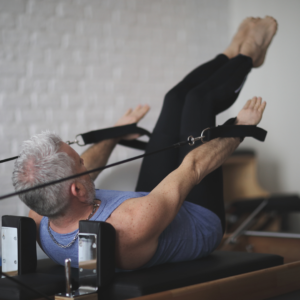Table of Contents
Introduction
Pilates Strengthens
Pilates' Cardiovascular Benefits
Pilates or Strength Training for Fitness?
Q&A Conclusion
"Discover the benefits of Pilates: A unique blend of strength training and cardio."
Introduction
Pilates improves posture, core strength, and flexibility. It involves mat or equipment-based controlled movements. Pilates is a strength-training method with cardiovascular benefits.

Pilates Strengthens
Pilates has become increasingly popular. This low-impact workout builds strength, flexibility, and balance. Many question if Pilates is aerobic or strength exercise. Depending on your approach, it can be both.
Pilates boosts strength. Pilates works the core, glutes, and legs. These exercises can build muscle and strength.
Pilates builds strength because it employs your own body weight as resistance. You can workout without equipment. Use your body to challenge and strengthen yourself.
Pilates strengthens core muscles. Core muscles support your spine and improve posture. These muscles promote stability and reduce injury risk.
Pilates strengthens and stretches. Pilates exercises stretch and lengthen muscles, improving range of motion. Tight muscles and limited mobility benefit from this.
Pilates is a great low-impact workout. It's mild on joints and ideal for folks with injuries or chronic pain. Pilates is low-impact and an excellent method to stay active without straining your joints.
Pilates for strength growth has several drawbacks. First, hire a skilled instructor to teach you the exercises and ensure appropriate form. This can prevent injury and maximise your workout.
Start cautiously and increase workout intensity. Beginners may find Pilates difficult. Start carefully and increase strength to avoid injury and maximise workout outcomes.
Finally, Pilates can boost strength and fitness. Pilates can help you improve your flexibility, balance, and low-impact workout. Find a trained instructor and start cautiously to maximise the benefits of Pilates.
Pilates' Cardiovascular Benefits
Pilates has been popular for over a century. Joseph Pilates developed it, believing physical and mental health were linked. Many question if Pilates can help cardiovascular health as well as strength. Pilates has several health benefits, including heart health.
Pilates is not cardio. Running, jumping, and other high-impact aerobic exercises are not involved. Pilates still improves cardiovascular health.
Pilates raises your heart rate to boost cardiovascular health. Pilates involves controlled, energy-intensive motions. This can raise your heart rate, strengthening it and improving blood flow.
Pilates boosts lung capacity and heart rate. Deep breathing during Pilates movements helps expand your lungs and increase oxygen intake. Asthmatics and COPD sufferers may benefit.
Pilates reduces stress and improves cardiovascular health. Stress causes heart disease and other health issues, therefore managing stress is crucial to overall health. Low-impact Pilates can relieve stress and relax. Focusing on your breath and motions can help you relax.
Finally, Pilates can boost your fitness, improving your cardiovascular health. Pilates strengthens, stretches, and balances the body. These fitness factors can lower injury risk and increase quality of life.
In conclusion, Pilates can improve cardiovascular health even though it's not aerobic. Pilates strengthens your heart and improves blood flow by raising your heart rate, lung capacity, fitness level, and stress reduction. Pilates is a low-impact workout that can improve your health.
Pilates or Strength Training for Fitness?
Pilates and strength training are often compared. Both can enhance fitness, but they have different goals. Is Pilates cardio or strength training?
Pilates strengthens core muscles, improves balance, and is low-impact. Joseph Pilates invented it in the early 20th century to enhance posture, stress, and fitness. Pilates is done on a mat on a reformer or Cadillac.
Strength training builds muscle and strength. Squats, deadlifts, and bench presses usually incorporate weights or resistance bands. Bodyweight, machine, or free weight strength training are options.
Pilates—cardio or strength? It's both, depending on how it's done. Pilates can be intensified for a cardiovascular workout. Jumping jacks or high knees can add cardio to a Pilates exercise. Pilates routines can be strengthened by adding resistance bands or weights.
Pilates emphasises core strength and flexibility. Traditional strength training neglects deep abdominal, back, and hip muscles, but these workouts address them. Pilates emphasises breathing and alignment to enhance posture and reduce injury risk.
Strength training builds muscle and strength. It improves metabolism, bone density, and chronic illness risk. Strength training strengthens muscles and joints, improving athletic performance and reducing injury risk.
Strength training or Pilates for fitness? Depends on your aims and preferences. Pilates may enhance core strength, flexibility, and posture. Strength training may be superior for building muscle, improving sports performance, and reducing chronic disease risk.
Pilates and weight training both improve fitness. Combining both types of exercise can give you a well-rounded workout that targets different body parts and has many benefits.
In conclusion, Pilates and strength training are two popular workout methods with different goals. Pilates focuses on core strength and flexibility and can be customised for cardio or strength training. Strength training builds muscle and strength. Choosing between Pilates and strength training depends on your objectives and tastes, but combining both can give you a well-rounded workout that targets different body parts and has many benefits.
Q&A
Is Pilates cardio?
Pilates is not cardio. Low-impact strength, flexibility, and balance training.
Is Pilates strength training?
Pilates is strength training. Bodyweight and resistance workouts tone and strengthen muscles.
3. Can Pilates replace strength training?
To get a well-rounded exercise, add weightlifting to your Pilates program.
Conclusion
Conclusion: Pilates builds core strength, flexibility, and muscle tone. It may not be cardio because it does not entail high-intensity motions that raise heart rate and breathing rate for a long time.


